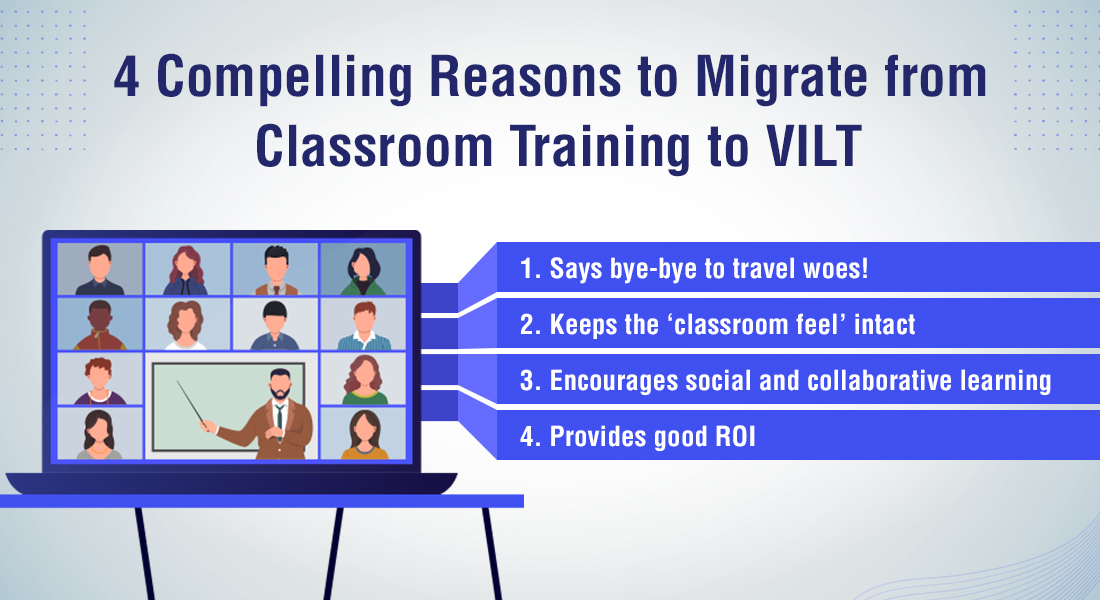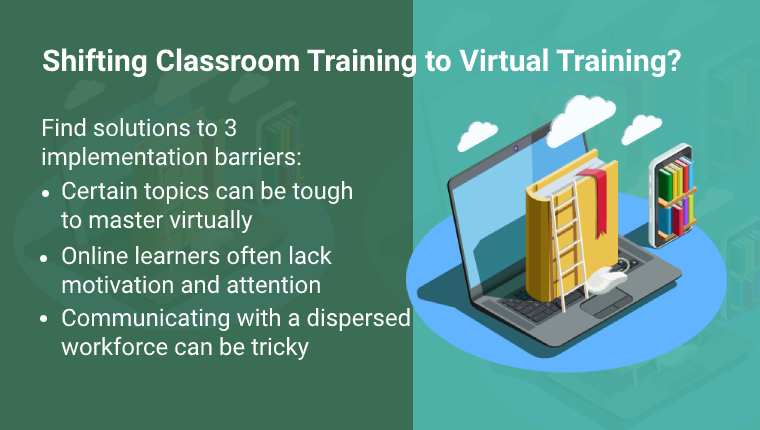4 Reasons Why Organizations Should Shift from Classroom Training to VILT

It’s been a tough year and it’s not over yet! COVID-19 descended on us like Voldemort, and sadly, Harry Potter was not around to save us. The world changed overnight, and corporate training was no exception. “How do we train our employees remotely in the most effective manner?” seems the most asked question in the industry today. What with social distancing and work from home, shifting from classroom training to VILT seems to be the only option for organizations to keep their training initiatives alive.
4 Reasons Why a Shift from Classroom Training to VILT Can Aid Your Organization:
- Says bye-bye to travel woes!
- Keeps the ‘classroom feel’ intact
- Encourages social and collaborative learning
- Provides good ROI
Virtual Instructor-led Training, also known as VILT, is the closest digital replica of in-person classroom training; it enables learners to have real-time interaction with an instructor, giving them most of the benefits of traditional classroom training from the comfort and safety of their homes. It saves on cost and time and is especially useful for employees who are dispersed in different locations, making learning easily accessible.
The aim of this blog is to provide a clear picture of the benefits of VILT and why you should shift from classroom training to VILT as soon as possible. Let’s explore!
Take a sneak peek into our VILT Beginner’s Guide here!
4 Reasons Why Organizations Should Shift from Classroom Training to VILT
1. Says Bye-Bye to Travel Woes!
Classroom training requires the learners and instructor/s to be physically present in a specific location at a scheduled time. With globalization, this means that very often, they need to travel to far away locations (sometimes, to different countries) for training. Organizations spend huge amounts of their training budgets on employees’ travel, lodging, food, etc. And organizing such classroom training sessions could also be a logistic nightmare!
All this can be eliminated with a shift from classroom training to VILT. VILT provides all the benefits of classroom training without having to step out of your home. Not only does it save time, energy, and cost for the learners and the organization, but ensures productive time for learners.
2. Keeps the ‘Classroom Feel’ Intact
Shortly after the coronavirus made an entry in 2019, all forms of classroom training came to an abrupt halt. Schools/ universities were shut down and office buildings turned into ghost towns with empty desks. All activities, including training, had to be done online. This is when the benefits of shifting from classroom training to VILT became obvious. Although traditional classroom training cannot be completely replaced by any other format of training, its principles can definitely be used for the benefit of the remote workforce (especially during COVID-19). That is the idea behind VILT, which uses principles of in-person classroom training, but through online platforms wherein the instructor and learners can attend the training from different locations.
Till the time we manage to win over COVID-19 (and maybe later too), VILT is the best alternative for employee training as it provides a lot of scope for high level interactivities (through chats, polls, whiteboards) that classroom training used to offer. VILT attempts to recreate the classroom experience in the best possible manner. These interactivities make learners feel as if they’re in a real classroom interacting with peers. Instructors and learners can share notes, have discussions, and ask questions. Let’s take a look at some commonly used interactivities in VILT:
- Whiteboards allow learners to scribble down information (on a virtual platform) just like on a regular whiteboard.
- Online Worksheet Activities can be used to add some fun to the learning process. These worksheets can be created on any topic, e.g. team building, communication, workplace ethics, etc.
- Polls can be used to determine learners’ existing level of knowledge, gather feedback on training from them, and to ask close ended questions to understand how much learners have retained of the learning.
- Chats are useful when the learner is not comfortable with asking or answering questions directly. Some learners have a lot to contribute, provided they are given a platform to write down their opinions. Such learners can utilize the chat function to give their views and receive feedback.
3. Encourages Social and Collaborative Learning
Although social learning and collaborative learning are closely related and may sound synonymous, there is a small difference between the two:
Social learning refers to informal learning with and from other individuals. It includes the use of social media discussion boards and casual conversations on a variety of topics that will help learners gain knowledge and insights. Learners observe one another’s responses and come up with different arguments. Collaborative learning, on the other hand, is more formal. It involves the use of group learning activities that improve learners’ skills. So, learners working together on a group project with colleagues, solving problems and sharing responsibilities is called collaborative learning.
Both collaborative learning and social learning became popular thanks to modern collaboration technologies that allow learners to come together on a virtual platform. For example, Breakout Rooms in VILT allow groups of learners to gather in sub-rooms for collaborative learning activities. They can take part in discussions and brainstorming and share their ideas during the VILT session. Now that traditional classroom training has been put on hold (there is also a possibility that we may never go back to the old way of training!), shifting from classroom training to VILT will give learners the opportunity to collaborate and socialize with their peers and instructors in the safest possible way, without missing out on the benefits of learning in a group.
4. Provides Good ROI
Once the organization makes a shift from classroom training to VILT, there’ll be a lot of saving on travel and lodging expenses. At the same time, learners get quality training, directly from an instructor, through VILT platforms such as Zoom, Google Classroom, etc., (there are many options one can choose from, based on individual requirements).
VILT is cost-effective since it reaches out to multiple learners located in different areas (sometimes in different countries/continents) and also reduces training costs per learner (no money spent on food, stationary, infrastructure, airfare, etc.). Additionally, it encourages a high level of interactivity, thus ensuring that the quality of training. This kind of training, in the long run, will make the learner an asset to the organization, meanwhile saving costs for the training departments too!
VILT is, no doubt, a great way for remote learning, especially during these times of isolation and social distancing. Shifting from classroom training to VILT is beneficial for the organization and the workforce since it combines elements of the ever popular and effective traditional face-to-face training with all the benefits of online learning, making the best of both worlds.
Want to know more about the magic of the virtual classroom? Take a look at our eBook for tips to generate motivation and excitement in the virtual classroom.



![4 Tips for a Successful Virtual Instructor-led Training [Infographic]](https://blog.commlabindia.com/hubfs/Imported_Blog_Media/virtual-instructor-led-training-success-tips-info.jpg)

